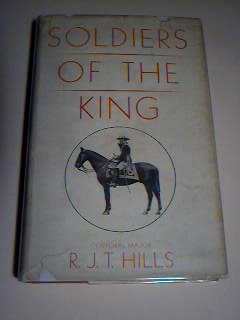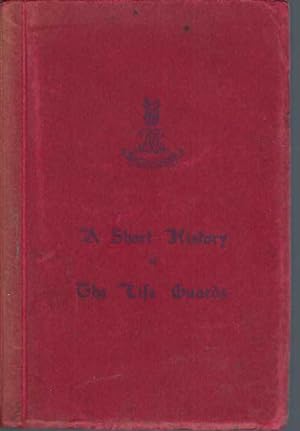corporal hills (3 resultados)
Tipo de artículo
- Todo tipo de artículos
- Libros (3)
- Revistas y publicaciones
- Cómics
- Partituras
- Arte, grabados y pósters
- Fotografías
- Mapas
-
Manuscritos y
coleccionismo de papel
Condición
- Todo
- Nuevos
- Antiguos o usados
Encuadernación
Más atributos
- Primera edición (1)
- Firmado
- Sobrecubierta (2)
- Con imágenes del vendedor (2)
- Sin impresión bajo demanda
Ubicación del vendedor
Valoración de los vendedores
-
Soldiers of the King
Publicado por Lovat Dickson and Thompson Ltd, 1935
Librería: best books, St. leonards on sea, Reino Unido
Libro
Hardcover. Condición: Very Good. Estado de la sobrecubierta: Good. something about a soldier. illustrated. dj has creasing, small tears and chippings. now in protective sleeve.
-
Soldiers of the King (Something Abour a Soldier)
Publicado por Lovat Dickson, London, 1935
Librería: Scorpio Books, IOBA, Bungay, Reino Unido
Libro
Cloth. Condición: Vg. Estado de la sobrecubierta: Fair. Cheap Edn. 294pp. Ink name fr.fly. Wrapper faded and chipped. Size: 8vo.
-
Short History of The Life Guards, A
Publicado por Gale & Polden Ltd., Wellington Works, Aldershot, 1933
Librería: Elizabeth's Bookshops, Fremantle, WA, Australia
Original o primera edición
Softcover. Condición: Very Good for its age. MILITARY HISTORY GENERALThe Life Guards (LG) is the senior regiment of the British Army and part of the Household Cavalry, along with the Blues and Royals.The Life Guards grew from the four troops of Horse Guards (exclusively formed of gentlemen-troopers until the transformation of the last two remaining troops into Regiments of Life Guards in 1788)[1][2] raised by Charles II around the time of his restoration, plus two troops of Horse Grenadier Guards (rank and file composed of commoners),[3] which were raised some years later.[4]The first troop was originally raised in Bruges in 1658 as His Majesty's Own Troop of Horse Guards. They formed part of the contingent raised by the exiled King Charles II as his contribution to the army of King Philip IV of Spain who were fighting the French and their allies the English Commonwealth under the Lord Protector Oliver Cromwell in the Franco-Spanish War and the concurrent Anglo-Spanish War.The second troop was founded in 1659 as Monck's Life Guards.The third troop, like the first troop was formed in 1658 from exiled Royalists and was initially known as The Duke of York's Troop of Horse Guards.The fourth troop was raised in 1661 in England.The first troop of horse grenadier guards was formed in 1693 from the amalgamation of three troops of grenadiers.The second troop of horse grenadier guards was raised in Scotland in 1702.These units first saw action during the Third Anglo-Dutch War in 1672 and then at the Battle of Sedgemoor during the Monmouth Rebellion in 1685.[5]The 3rd and 4th troops were disbanded in 1746.[4] In 1788, the remaining 1st and 2nd troops, along with the two troops of Horse Grenadier Guards, were reorganised into two regiments, the 1st and 2nd Regiments of Life Guards (from 1877, simply 1st Life Guards and 2nd Life Guards).[4] From then on (1788), rank and file were mostly formed of commoners (pejorative nickname: "cheesemongers"),[6] the bulk of the gentlemen-troopers were pensioned off.[7]In 1815 they were part of The Household Brigade at the Battle of Waterloo under Major-General Lord Edward Somerset.[5]In 1821, the Life Guards under the command of Captain Oakes fired upon mourners trying to redirect the funeral procession of Queen Caroline through the city of London. Two civilians were killed. Though charges of manslaughter and murder were brought, no guardsmen were prosecuted.[8]In late 1918, after much service in the First World War, the two regiments gave up their horses and were re-roled as machine gun battalions, becoming the 1st and 2nd Battalions, Guards Machine Gun Regiment. They reverted to their previous names and roles after the end of the war.[5] In 1922, the two regiments were merged into one regiment, The Life Guards (1st and 2nd).[4] In 1928, it was re-designated The Life Guards.[5] pp. 107 + 4 fold-out battle maps. Ink stain to top side and back cover, some foxing, otherwise sound - Very Good. SCARCE. First Edition. #141022 Elizabeth's Bookshops have been one of Australia's premier independent book dealers since 1973. Elizabeth's family-owned business operates four branches in Perth CBD, Fremantle (WA), and Newtown (NSW). All orders are dispatched within 24 hours from our Fremantle Warehouse. All items can be viewed at Elizabeth's Bookshop Warehouse, 23 Queen Victoria Street\, Fremantle WA.




